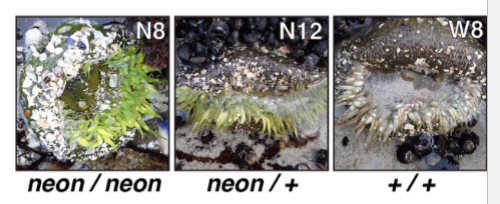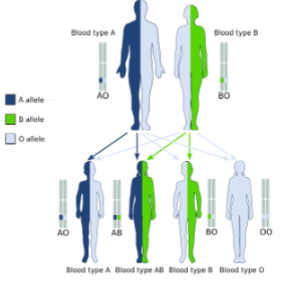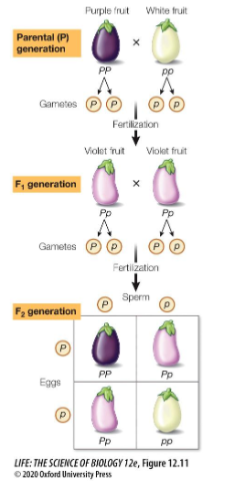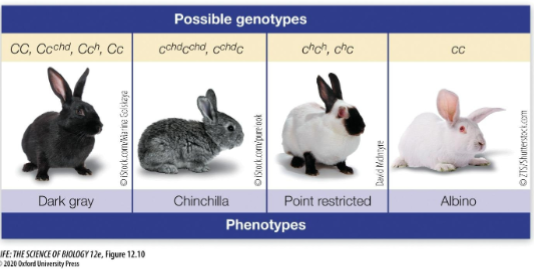Phenotypes, Genotypes, Reproduction, & Inheritance
1/102
There's no tags or description
Looks like no tags are added yet.
Name | Mastery | Learn | Test | Matching | Spaced |
|---|
No study sessions yet.
103 Terms
Genotype
information stored in DNA
Phenotype
all structures, processes, and behaviors of an organism
Genotype + Environment →
Phenotype
Phenotypic changes are due to environment are
not heritable
Phenotypic Plasticity
the ability of individuals with a particular genotype to express different phenotypes as a result of environmental differences
Monogenic traits
controlled by a single gene
Polygenic traits
due to the action of multiple genes interacting with one another through integrated pathways
Phenotypic Variation)
individuals vary for a given trait in a population; the result of the interaction between information from the environment and genotype
Continuous Variation
average phenotype that most individuals cluster around; aka height
Discrete variation
a trait typically exhibits either one phenotype or another
VG
variation in the population’s genotype
VE
variation in the population’s environment
VGE
specific interactions of genotype and environment
2 non-random mechanisms of evolution
natural selection and sexual selection
What are the three key requirements for phenotype selection?
phenotypic variation, heritability, overproduction of offspring
Heritability
genotype component of phenotype to be passed on to offspring
Natural Selection vs. Sexual Selection
NS- differential survival; SS- differential reproductive success
DNA
double helix of base pairs containing the fundamental hereditary information of a living organism
Chromatin
DNA combined with proteins; heterochromatin & euchromatin
Heterochromatin
condensed, densly packed
Euochromatin
uncondensed, diffuse
Chromosomes
discrete structures composed of chromatin; can be totally condensed or certain parts extended
Ploidy
number of types of chromosomes in a cell
Haploid
1N; one set of chromosomes; one version of each gene
Diploid
2N; two complete (and different) sets of chromosomes; 2 versions of each gene
Polyploid
more than two versions of info; ex: tetraploid, 4N
What are the mechanisms to preserve DNA sequence?
proofreading, mismatch repair, replace damage bases
Mitosis
eukaryote cell division that results in 2 genetically identical daughter cells
What does mitosis end with?
two identical 2N cells
Meiosis
eukaryote cell division that results in 4 genetically unique daughter cells
What does Meiosis 1 end with?
two genetically unique 1N cells
What does Meiosis (II) end with?
4 genetically unique 1N cells
Crossing Over
the mechanism where homologous chromatids exchange corresponding segments of DNA; change info only with exchanging with chromatid from other parent
Independent Assortment
the mechanism where homologous pairs line-up randomly in Meiosis I, leading to random chromosome combinations in daughter cells
How do you increase variation?
DNA repliation, meiosis (crossing-over + independent assortment), synagmy
What is the purpose of sex?
genetic recombination so offspring genotypes are unique from parental genotypes
Advantages of Sexual Reproduction
Hedging bets; Red Queen hypothesis
Disadvantages of Sexual Reproduction
offspring only receive half of each parent’s genes; can be hard to find mate; potential mates must be genetically compatible; offspring may be less fit than either parents
Hedging Bets
if environmental (abiotic/biotic) conditions change, having wide range of phenotypes in offspring will ensure some will survive/pass on genes
Hedging Bets Example
Peppered Moth vs. Industry
Red Queen Hypothesis
other organisms are constantly evolving biotic conditiosn that genetic recombination creates favorable combinations of genes to rapidly keep up
Gene
a segment of DNA that contains the instructions for building a specific protein or performing a particular function
Locus
the physical location (singular) of a gene sequence on the DNA strand
Loci
the physical location (multiple) of a gene sequence on the DNA strand
Allele
functionally different variants of a gene; diploid organisms have 2 alleles of each gene
Homozygous Alleles
diploid individual contains two functionally identical alleles of a particular gene
Heterozygous Alleles
a diploid individual posessing two different alleles for a gene
Simple Dominance
some alleles are dominant over others (will be expressed if there is 1 allele) and some are recessive (need 2 alleles to express)
Partial or Incomplete Dominance
each genotype is associated with a distinct phenotype; can be varying in the range between dominant and recessive genotypes
Semi-Dominance
the heterozygote’s phenotype is exactly intermediate between the phenotype of each homozygote
Co-Dominance
both alleles contribute equally to the phenotype; often dominate over other alleles
In Dachshunds, hair length is controlled by alleles at the FGF5 locus. A cross between a short hair and long hair parent produces all short haired puppies. What is the mode of inheritance?
simple dominance

In some sea anemones, a neon AnthoYFP allele encodes for a visibly brighter variant. Here are some phenotypes of homozygote and heterozygote anemones. What is the mode of inheritance?
partial or incomplete dominance

What is the mode of inheritance for blood?
co-dominance

What is the mode of inheritance of the fruit?
semi-dominance

Many genes have multiple alleles, which increases the possible number of phenotypes for the trait. There are 4 alleles for rabbit coat color shown here:
• The C allele leads to dark
grey fur
• The cchd allele leads to a
lighter grey fur
• The ch allele leads to
restricted pigment
deposition
• The c allele leads to no
pigment deposition
What is the mode of inheritance?
simple dominance
Epistasis
one gene alters/masks/interacts with the phenotypic effect of another gene
Pedigree inheritance
the study of how traits are transmitted across generations by analyzing family trees to identify genetic patterns
Autosomal Dominant Inheritance
only one copy of the altered allele is needed to show trait/disorder; no carriers
Autosomal Recessive Inheritance
must inherit two copies of altered gene to show trait/disorder; can have carriers (have gene but no symptoms- heterozygotes)
Genetic Linkage
genes on the same chromosomes; will not segregate independently
Completely linked genes
genes close together bc cross-over between them is unlikely
Incompletely linked genes
genes are far apart so cross-over is more likely
Aneuploidy
atypical number of chromosomes (too many or two few)
Gene Dosage
number of genes; can be changed with too many or too few chromosomes (aneuploidy)
Reproduction
process that allows organisms to create new individuals
Sexual Reproduction produce
genetically distinct offspring
Asexual Reproduction produce
genetically identical offspring
No alterations
diploid organism has germ cells that undergo meiosis to produce gametes for sexual reproduction
Alterations of Generations
Cells of diploid organism undergo
meiosis to produce spores, which
both grow AND produce gametes
via mitosis
Alternation of Strategies
Diploid organism can undergo
asexual reproduction,
OR produce gametes via meiosis
for sexual reproduction
What are the ways multicellular organisms reproduce?
no alternation, alteration of strategies, alternation of generations
Mechanisms of Asexual Reproduction for unicellular organisms
binary fission (Bacteria/Archaea) & binary fission through mitosis (eukaryotes)
Mechanisms of Asexual Reproduction for Multicellular Organisms
parthenogenesis, budding, regeneration, vegetative propagation
Parthenogenesis
development of offspring from unfertilized gametes
Budding
new individuals form as outgrowth from body of older individual
Regeneration
growth of new individual from pieces of older individual
Vegetative Propagation
term for budding/regeneration in plants
Mechanisms of Sexual Reproduction
spawning, direct transfer, indirect transfer
Spawning
external or internal fertilization; release gametes into the environment
Direct Transfer
transfer of gametes via intermittent organ (internal fertilization)
Indirect Transfer
transfer of gametes via spermatophore; internal fertilization
Gametes
haploid (1N) cells that fuse together in sexual reproduction
Organisms that typically produce fewer, larger gametes are considered
female
organisms that typically produce more, smaller gametes are considered
males
Can some organisms produce both types of gametes?
yes
Sexes can be defined by
the type of gamete produced (phenotype)
Environment Factors for Sex Determination
Hormone levels, Temperature, Size, Social Cues, Access to
resources (ex. food), Location
Phenotype Factors for Sex Determination
Gamete produced, Primary Sexual
characters, Secondary Sexual
characters
Genotype Factors for Sex Determination
Ploidy (N vs 2N) & Sex
chromosomes (if present) aka XX & XY + ZZ & ZW
What can affect Sex Determination?
Individuals may make 1, both, or neither type of gamete, + Cells, tissues, organs that aid in gamete production, + Structures for gamete release or delivery, + Mechanisms/structures tied to development
Temperature Determining Sex
in many reptiles and some fish; proportion of sex depends on nest temperature and parental care can affect it too
Access to Food Determining Sex
in some eusocial insects (bee, ants, wasps); being fed a special food throughout development can determine sex
Naked Mole Rat Determining Sex
reproductives ones suppress the reproductive development of other females by expressing certain pheromones in their urine
Reproductive Parasite in Determining Sex
Wolbachia infect anthropods and nematods which may preferentially kill-off male larvae, feminization of chromosomal males, parthenogenesis, mating incompatibility
Location in Determining Sex
Bonellia viridis larvae on sea floor develop female morphology but land on female proboscis enter gut and develop male morphology
Age/Size or Social Cues
some fish begin life as one sex, then change to another upon reaching a given size/age or social cue with hierarchy
Monoecious
single individual that produces both male and female gametophytes; may be capable of self-pollination and/or cross-pollination
Dioecious
female and male gametophytes are produced by different individuals who are incapable of self-pollination
Gymnosperms
2 types of cones; seed cones- egg-producing gametophyte; pollen cones- pollen = sperm-producing gametophyte